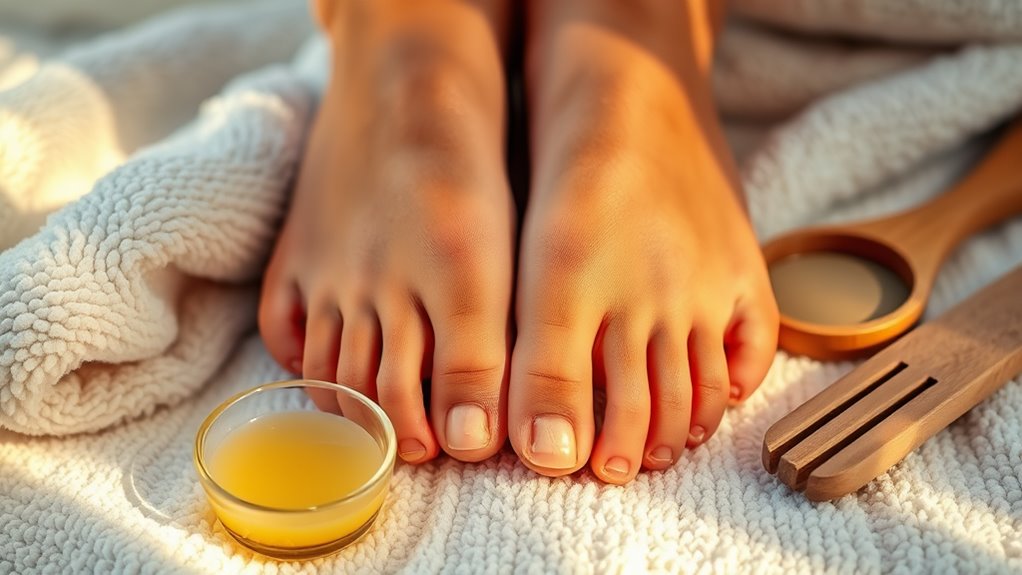Cracked Heels. Try These Simple Home Fixes Today
Cracked heels can be a frustrating issue, often resulting from dry skin or inadequate footwear. You might notice painful fissures and redness that make everyday activities uncomfortable. Fortunately, there are simple home fixes that can help restore your heels to their former softness. By understanding the causes and exploring effective treatments, you can take the first steps toward healthier feet. Let’s look at some practical solutions to address this common problem.
Key Takeaways
- Soak your feet in warm water for 15-20 minutes to soften skin and prepare for exfoliation.
- Use a pumice stone or foot file to gently remove dead skin after soaking.
- Apply a thick foot cream or petroleum jelly to keep your feet hydrated, especially at night.
- Incorporate regular exfoliation into your routine, ideally twice a week, to prevent build-up.
- Wear well-fitting shoes and moisturize daily to maintain foot health and prevent cracked heels.
Understanding Cracked Heels: Causes and Symptoms
Have you ever wondered what causes those painful cracks in your heels?
Cracked heels often result from dry skin, pressure on the feet, or improper footwear. Factors like obesity, diabetes, and certain skin conditions can exacerbate the issue. Cracked heels indicate potential underlying issues that may need further attention.
Symptoms include visible fissures, redness, and discomfort, especially when standing or walking.
To alleviate this condition, many turn to cracked heel natural solutions such as moisturizing creams, essential oils, and regular exfoliation.
Soaking Your Feet: The First Step to Healing
Soaking your feet in warm water is an essential first step in healing cracked heels. The warmth helps to soften the skin, making it easier to exfoliate and remove dead cells. This soak can also provide instant pain relief for tired feet, enhancing the overall healing experience.
Warm Water Benefits
One of the most effective ways to initiate healing for cracked heels is by soaking your feet in warm water.
This simple practice not only hydrates your skin but also helps to soften the hardened areas, making it easier to address cracks. Warm water increases blood circulation, promoting overall foot health and easing any discomfort.
Additionally, it prepares your feet for further treatment, enhancing the efficacy of moisturizers and ointments applied afterward.
Exfoliating Soaking Techniques
How can you enhance the effectiveness of your foot care routine?
Start with exfoliating soaking techniques that will prepare your feet for healing.
Soak your feet in warm, soapy water for about 15-20 minutes to soften the skin.
After soaking, use a pumice stone or foot scrub to gently exfoliate the heels.
- Add Epsom salt for added healing benefits.
- Incorporate essential oils like tea tree or lavender for their soothing properties.
- Moisturize immediately after exfoliation to lock in hydration.
- Repeat this process two to three times a week for optimal results. Enjoy smoother, healthier feet!
Exfoliation Techniques for Smooth Skin
Start by using a pumice stone after soaking your feet in warm water. This helps remove dead skin. You can also try a foot scrub containing natural exfoliants like sugar or salt. Gently massage the scrub onto your heels in circular motions. Alternatively, consider using a foot file for targeted exfoliation. For a chemical approach, look for products containing alpha-hydroxy acids or salicylic acid, which can help dissolve dead skin cells. Regular exfoliation, about twice a week, will keep your heels smooth and healthy. Additionally, incorporating regular exfoliation into your routine is crucial for maintaining the texture and health of your feet.
Moisturizing Remedies to Restore Softness
Moisturizing your heels is essential for restoring softness and preventing cracks.
To effectively hydrate and nourish your skin, consider incorporating these moisturizing remedies into your routine:
- Use a thick cream or lotion specifically designed for feet.
- Apply petroleum jelly before bed for overnight hydration.
- Massage in aloe vera gel for its soothing properties.
- Try a foot mask once a week for an intensive treatment. Additionally, keeping your feet properly moisturized can significantly reduce the risk of developing cracked heels.
Natural Oils for Deep Hydration
Natural oils can be a game-changer when it comes to deep hydration for cracked heels. Oils like coconut, olive, and almond penetrate the skin effectively, providing essential moisture and nutrients.
Coconut oil, rich in fatty acids, promotes healing and soothes irritation. Olive oil offers antioxidants and anti-inflammatory properties, while almond oil nourishes and softens the skin. To maximize benefits, make sure your heels are clean and dry before applying these oils generously before bedtime, and consider wearing socks to lock in the moisture overnight.
With consistent use, you’ll notice a significant improvement in the texture and appearance of your cracked heels.
Hydrate deeply and enjoy softer feet!
Prevention Tips for Healthy Feet
How can you keep your feet healthy and prevent cracks from forming?
Follow these essential tips for maintaining foot health:
- Moisturize Daily: Apply a good foot cream every day to keep your skin hydrated.
- Wear Proper Footwear: Choose shoes that fit well and provide adequate support, avoiding tight or ill-fitting options.
- Stay Hydrated: Drink plenty of water to maintain skin elasticity and overall health.
- Exfoliate Regularly: Use a pumice stone or foot scrub to remove dead skin and prevent buildup.
Implementing these simple practices can help you enjoy healthier, crack-free feet.
